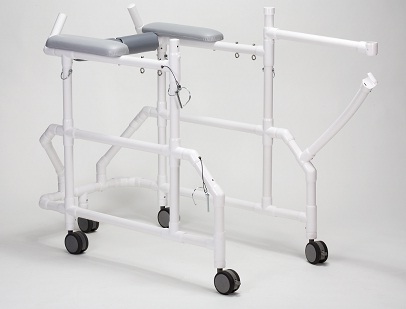The final result will be share on Monday.
First of all, every Sunday for the past month I have been volunteering at Gliding Stars in Toledo, (http://glidingstars.org/index.html) which is an adaptive ice skating program. I love it! I have been paired up with a variety of fun children and adolescents to help teach ice skating techniques and moves for the ice performance. There is this one adolescent that my friends and I have taken note of. He has out grown his walker considerably to the point where he can not move his legs effectively and the seat, for a boy, is not very comfortable at all! It is a bike seat changed with straps in the front and back but the bike seat was meant for a child, not a 5'7'' growing man.
I will insert Pic here soon. of original walker...
My friends and Home Depot have taken on the challenge to build this young man a new ice skating device so he could actually use his legs and push him self. I am still unsure the amount of disclosure I am allowed. He has considerable amount of spasticy in his UE. Measurements we took included his amount of pronation (unable to reach neutral position) shoulder flexion, wrist flexion and extension, current position of ulnar or radial deviation in wrist, abduction of shoulder, as well as height, weight, and length of all body segments. While visiting the skater, we discussed needs such as where he has most control, where he lacks good muscle coordination, ability to hold self, the necessity of a seat and personal goals of the young man.
after searching for a walker through multiple organizations and companies, we came across a design online with PVC pipes

Specifications
| Weight | 41 lbs. |
| Weight capacity | 250 lbs. |
| Top frame inside width | 19.25" |
| Top frame outside width | 29.5" |
| Bottom frame inside width | 22" |
| Bottom frame outside width | 26" |
| Armrest width | 5" |
| Armrest height range | 39.25" - 59.25" |
| Overall length | 4 |
The following pics shows the progression of building the walker. THANK YOU HOME DEPOT!!
 The back!
The back!
 Angle of arm rests allows for amount of pronation. Due to the possibility of growth and needing to re angle arm rests. instead of gluing, we screwed in the poles that will need to be adjusted.
Angle of arm rests allows for amount of pronation. Due to the possibility of growth and needing to re angle arm rests. instead of gluing, we screwed in the poles that will need to be adjusted.
Total Time: 4.5 hours
Supplies used: Five 10-foot 3/4 inch PVC pipes, multiple 45 degree angles, 19 three-ways, 6 four-ways.
Price online: $850
Estimated price including $10/hr for labor:
$255
we will say $350 including tools and if they want a raise



















